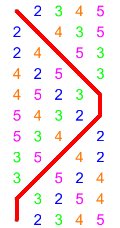Plain Hunt Toolbox
What is Plain Hunt?
Plain Hunt will probably be the first time that you will have to move your bell at every change. It is the simplest form of change ringing but it will require you to learn and apply various new concepts, all at the same time:
- You will have to remember a sequence of places – there is no conductor telling you which place to ring in, as happens in call or kaleidoscope changes.
- it is important to know in which position in the change your bell is ringing, and helpful to be aware of which bell you are following (known as ropesight).
- This may be the first time that you will need to adjust the speed of your bell at every stroke, moving at both handstroke and backstroke.
- Unlike call changes, all the bells change position (place) in the row on each and every stroke, except when leading or lying when they ring two blows in the same place.
The path of the bells can be shown in the form of a line that represents the movement of each bell amongst the others. This line, for historical reasons, is known as the blue line although it is frequently represented by various colours. The diagram shows the path of the treble, marked in red, plain hunting on five bells. It represents one lead. Each bell follows the same path but starts in a different place. For example:

- The treble starts by ringing rounds in first place. When Plain Hunt starts it rings in seconds, thirds, fourths and fifths place on consecutive strokes. It rings a second blow in fifths place (know as lying) and then hunts down to the front, ringing in fourths, thirds, seconds and then first place. Plain Hunt comes round when the treble rings its second blow in first place (leading).
- Now, for example, look at the path of the 5. When Plain Hunt starts it rings a second blow in fifths places and then hunts down to the front, ringing in fourths, thirds, seconds and then first place. It rings a second blow in first place and then rings in seconds, thirds, fourths and fifths place. Plain Hunt comes round when the fifth rings its first blow in fifth place (lying).
Download the Plain Hunt chart and look at the path of the other bells. All the bells ring the same line or order of places starting in a different place.
» Plain Hunt chart
» Plain Hunt jargon buster
Ringing Plain Hunt
The conductor will calls “Go Plain Hunt” on a handstroke. You ring the following backstroke in rounds and your first change is the next handstroke. When the conductor wishes you to stop ringing Plain Hunt, they will call "That's All" and rounds is rung. Remember:
- Odd bells go out – they hunt up to the back, starting with slow blows.
- Even bells go in – they hunt down to the front, starting with quick blows.
Note that when ringing Plain Hunt on an odd number of bells, the last bell (the 5 in doubles and the 7 in triples) starts by making a place.
Ringing your bell in the right place
Try to ring Plain Hunt on as many different bells as you can, with the proviso that you need to be able to control the bell to be able to position it in the right place in the change. You will have practised changing the position of your bell whilst ringing call and kaleidoscope changes, which required you to ring your bell at three different speeds.
» Ringing at three different speeds
» Counting your place
Learning aids
» Plain Hunt jargon quiz
» Plain Hunt dominoes
» Plain Hunt quiz
» Plain Hunt worksheet
Learning using a simulator
Plain Hunt introduces some new skills – ropesight and hearing your bell as you move place – which you can practise using a ringing simulator. Here are some tips about setting up a simulator to help you hear your bell and see which bells you are passing.
Changing the volume of a single bell
Using ropesight flashes
Teaching aids
» Walking Plain Hunt
» Plain Hunt on a single handbell
» The backstroke length
» Solving common problems
Plain Hunt workshop
How to set up a Plain Hunt workshop including theory session.
» Workshop presentation
» Workshop notes
Theory sessions
Use these notes and either the crib sheets or the workshop presentation as visual aids.
» Notes for theory sessions
Stepping stone methods
Plain Hunt on 2 bells
» Big Change, Little Change
» Bastow Minimus
» Bistow Doubles
Plain Hunt on 3 bells
» Cloister Doubles – Plain Bob start
» Cloister Doubles – Grandsire start
» Ashford Little Bob Doubles
Plain Hunt on 4 bells
» Whitefield Places
Plain Hunt on 5 bells
» Penultimus Doubles
» Flying Dutchman
Theory
» Course and after bells
» Course and after bells – a game
Teaching using simulators
How to set up a simulator to teach Flying Dutchman by adding a composition.